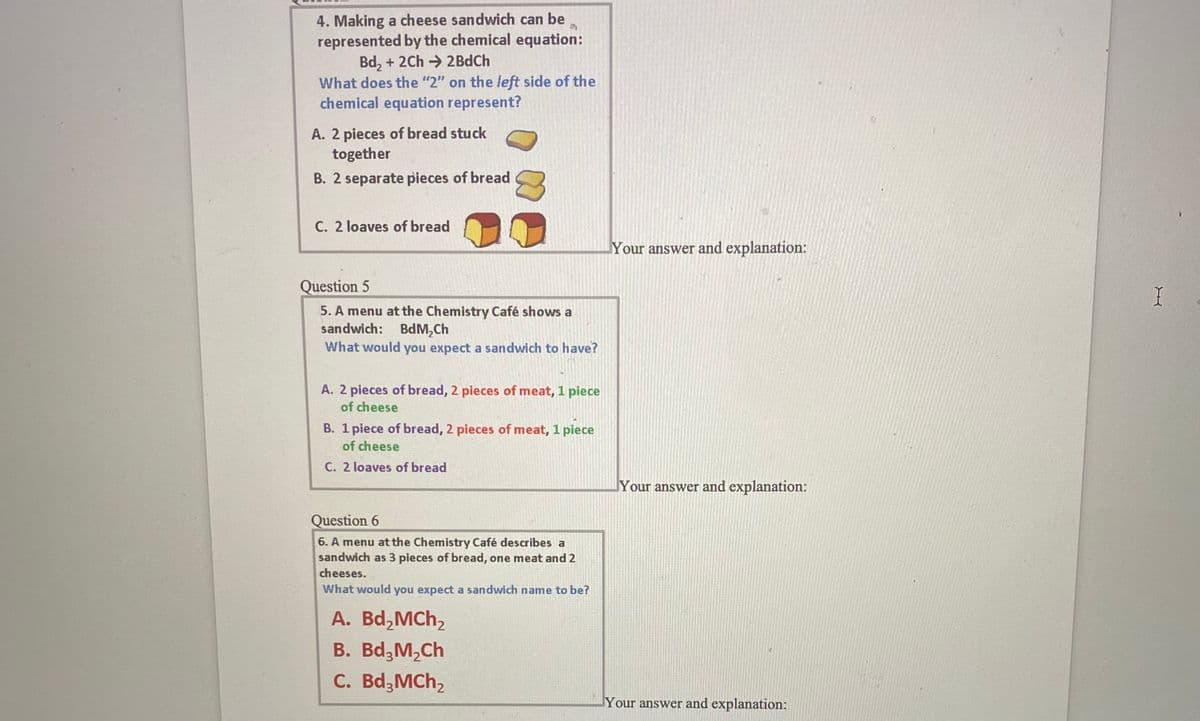4. Making a cheese sandwich can be represented by the chemical equation: Bd, + 2Ch → 2BDCH What does the "2" on the left side of the chemical equation represent? A. 2 pieces of bread stuck together B. 2 separate pieces of bread C. 2 loaves of bread Your answer and explanation: Question 5 5. A menu at the Chemistry Café shows a sandwich: BdM,Ch What would you expect a sandwich to have? A. 2 pieces of bread, 2 pieces of meat, 1 piece of cheese B. 1 piece of bread, 2 pieces of meat, 1 piece of cheese C. 2 loaves of bread Your answer and explanation: Question 6 6. A menu at the Chemistry Café describes a sandwich as 3 pieces of bread, one meat and 2 cheeses. What would you expect a sandwich name to be? А. Bd,MChz В. Bd,M,Ch С. Bd, MCh Your answer and explanation:
4. Making a cheese sandwich can be represented by the chemical equation: Bd, + 2Ch → 2BDCH What does the "2" on the left side of the chemical equation represent? A. 2 pieces of bread stuck together B. 2 separate pieces of bread C. 2 loaves of bread Your answer and explanation: Question 5 5. A menu at the Chemistry Café shows a sandwich: BdM,Ch What would you expect a sandwich to have? A. 2 pieces of bread, 2 pieces of meat, 1 piece of cheese B. 1 piece of bread, 2 pieces of meat, 1 piece of cheese C. 2 loaves of bread Your answer and explanation: Question 6 6. A menu at the Chemistry Café describes a sandwich as 3 pieces of bread, one meat and 2 cheeses. What would you expect a sandwich name to be? А. Bd,MChz В. Bd,M,Ch С. Bd, MCh Your answer and explanation:
Introductory Chemistry: An Active Learning Approach
6th Edition
ISBN:9781305079250
Author:Mark S. Cracolice, Ed Peters
Publisher:Mark S. Cracolice, Ed Peters
Chapter8: Chemical Reactions
Section: Chapter Questions
Problem 1E: Consider the following particulate-level representation of a chemical equation: The white spheres...
Related questions
Question
Please explain answer

Transcribed Image Text:4. Making a cheese sandwich can be
represented by the chemical equation:
Bd, + 2Ch → 2BdCh
What does the "2" on the left side of the
chemical equation represent?
A. 2 pieces of bread stuck
together
B. 2 separate pieces of bread
C. 2 loaves of bread
Your answer and explanation:
Question 5
5. A menu at the Chemistry Café shows a
sandwich: BdM,Ch
What would you expect a sandwich to have?
A. 2 pieces of bread, 2 pieces of meat, 1 piece
of cheese
B. 1 piece of bread, 2 pieces of meat, 1 piece
of cheese
C. 2 loaves of bread
Your answer and explanation:
Question 6
6. A menu at the Chemistry Café describes a
sandwich as 3 pieces of bread, one meat and 2
cheeses.
What would you expect a sandwich name to be?
А. Bd,Mchz
В. Bd,M,Ch
C. Bd,MCh,
Your answer and explanation:
Expert Solution
This question has been solved!
Explore an expertly crafted, step-by-step solution for a thorough understanding of key concepts.
This is a popular solution!
Trending now
This is a popular solution!
Step by step
Solved in 3 steps

Knowledge Booster
Learn more about
Need a deep-dive on the concept behind this application? Look no further. Learn more about this topic, chemistry and related others by exploring similar questions and additional content below.Recommended textbooks for you

Introductory Chemistry: An Active Learning Approa…
Chemistry
ISBN:
9781305079250
Author:
Mark S. Cracolice, Ed Peters
Publisher:
Cengage Learning

Introductory Chemistry: A Foundation
Chemistry
ISBN:
9781337399425
Author:
Steven S. Zumdahl, Donald J. DeCoste
Publisher:
Cengage Learning

Chemistry: The Molecular Science
Chemistry
ISBN:
9781285199047
Author:
John W. Moore, Conrad L. Stanitski
Publisher:
Cengage Learning

Introductory Chemistry: An Active Learning Approa…
Chemistry
ISBN:
9781305079250
Author:
Mark S. Cracolice, Ed Peters
Publisher:
Cengage Learning

Introductory Chemistry: A Foundation
Chemistry
ISBN:
9781337399425
Author:
Steven S. Zumdahl, Donald J. DeCoste
Publisher:
Cengage Learning

Chemistry: The Molecular Science
Chemistry
ISBN:
9781285199047
Author:
John W. Moore, Conrad L. Stanitski
Publisher:
Cengage Learning

World of Chemistry, 3rd edition
Chemistry
ISBN:
9781133109655
Author:
Steven S. Zumdahl, Susan L. Zumdahl, Donald J. DeCoste
Publisher:
Brooks / Cole / Cengage Learning

Chemistry for Engineering Students
Chemistry
ISBN:
9781337398909
Author:
Lawrence S. Brown, Tom Holme
Publisher:
Cengage Learning

Chemistry: Principles and Reactions
Chemistry
ISBN:
9781305079373
Author:
William L. Masterton, Cecile N. Hurley
Publisher:
Cengage Learning